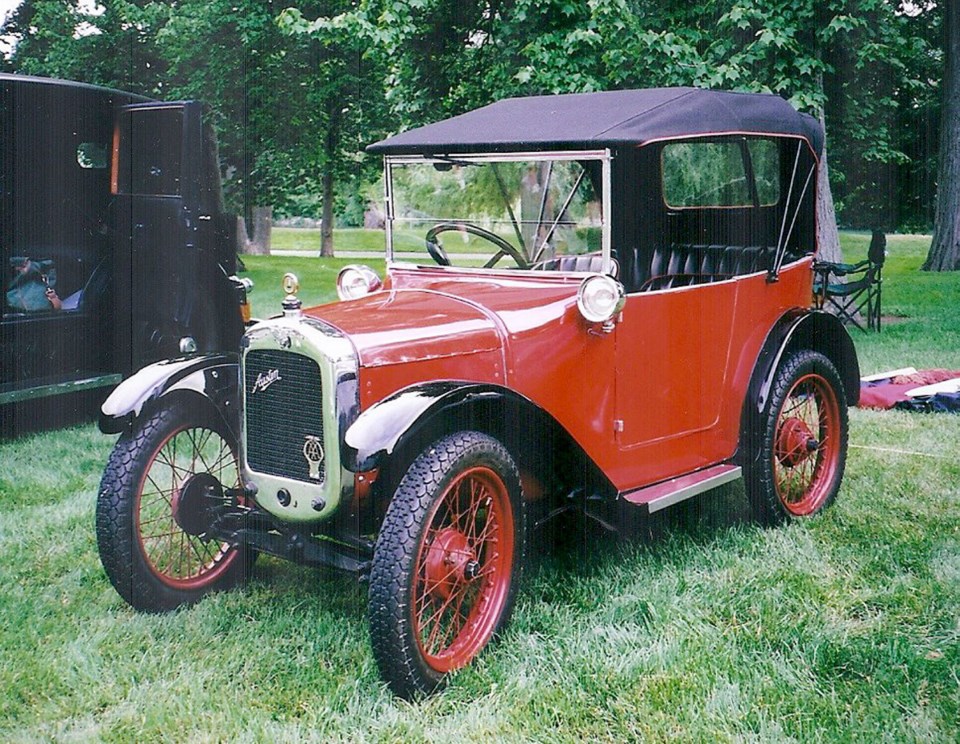The Austin Seven cold be called the English Model T Ford or German Volkswagen Beetle: simple, sturdy, reliable transportation for the masses. The fact that they were all built in several countries attests to their popularity. The Seven was the tiniest of the three.
The Austin story began when Herbert Austin resigned as general manager of Wolseley Tool and Motor Car Co., Birmingham, in 1905 and established the Austin Motor Co. in nearby Longbridge.
It built a variety of models from 1906 to the outbreak of the First World War in 1914. Most models had four cylinders, although there were some sixes, including a giant 60-horsepower, 9.7-litre model.
After the war, Austin went to a one-model policy — the Model Twenty, with a 3.6-litre side-valve four. It appeared in 1919, but sold so poorly Austin was soon in receivership.
The one-model policy was abandoned, and a scaled-down Twenty called the Twelve was developed with a 1.6-litre engine. It turned Austin’s financial fortunes around, but Herbert Austin saw the need for an even lighter, more affordable car, probably influenced by the Model T and the tiny French Peugeot Quadrilette.
The legend is that opposition was so strong among company colleagues that Austin did the initial layout for the Austin Seven, named for its taxable horsepower, on his home billiard table. The design was completed by 18-year-old draughtsman Stanley Edge during the winter of 1921-22.
Minimum family transportation was often a motorcycle and sidecar, so Austin wanted his new car to occupy about the same space. The car that emerged was tiny even by British standards.
The Seven’s wheelbase was a diminutive 1,905 millimetres, length was only 2,692 mm and weight was about 454 kilograms. To put this in perspective, the tiny, front-drive BMC Mini introduced in 1959 had a 2,032-mm wheelbase, 3,048 mm length and weighed 572 kg.
Suspension was a transverse leaf spring in front and two quarter-elliptics at the rear. Mechanical brakes operated on all four wheels, very advanced for the time, with the front ones applied by the brake pedal and the rears by a lever (they all became pedal-operated in the 1930s).
The 696-cc (soon enlarged to 747-cc) side-valve, water-cooled four had a two-bearing crankshaft and produced 10.5 horsepower. Austin had originally wanted an air cooled two-cylinder, but Edge wisely convinced him he could design a four that would be smoother, quieter and no more costly.
In spite of the internal opposition, Austin was able to bring his tiny car to market. Some motoring journalists derided it as a toy, and there was some disdain within the company itself. But this was before English aviation pioneer Gordon England took an interest in the Seven.
Convalescing in hospital with a broken leg, England studied the Seven’s specifications and concluded it would be an excellent choice to attack 750-cc speed records. He wrote to Herbert Austin with his idea, and a meeting was arranged.
In due course, a new Austin Seven arrived at England’s home, and with the help of Sammy Davis, editor of The Autocar magazine, and the co-operation of the Brooklands race track, England’s modified Seven broke several 750-cc records.
England designed his Speed Model Seven, also known as the Brooklands Super Sports, with modifications including lighter pistons, higher compression, high-lift camshaft and pressurized lubrication. Austin also developed its own fast Ulster model. The Seven set more records and won many races; it was no longer the butt of jokes.
The Seven was welcomed in the market, becoming the company’s best-selling model until 1932. It helped Austin through the Depression and effectively replaced the motorcycle and sidecar for modest families.
It was built until 1939 with periodic improvements. Electric starting came in 1923, and in the 1930s the wheelbase was increased 152 mm. A four-speed transmission replaced the original three-speed, and bumpers were added.
The Seven was also built in other countries. BMW made Sevens in Germany under licence called Dixis. Versions were produced in France by Rosengart and Japan by Datsun.
The American Austin Car Co. of Butler, Pennsylvania, built Americanized Austin Sevens, and later derivative American Bantams with limited success. Americans wanted bigger cars.
The Austin Seven, Model T Ford and Volkswagen Beetle helped put the world on wheels. Although total production of about 300,000 Sevens was nothing like 15 million-plus Model Ts or 22 million-plus Beetles, it did create its own special niche in automotive history.
The name was revived in 1952 in a tiny, unit-construction car, and in 1959 the front-drive Mini. But for longtime Seven enthusiasts, the “real” Austin Seven was that tiny original.



